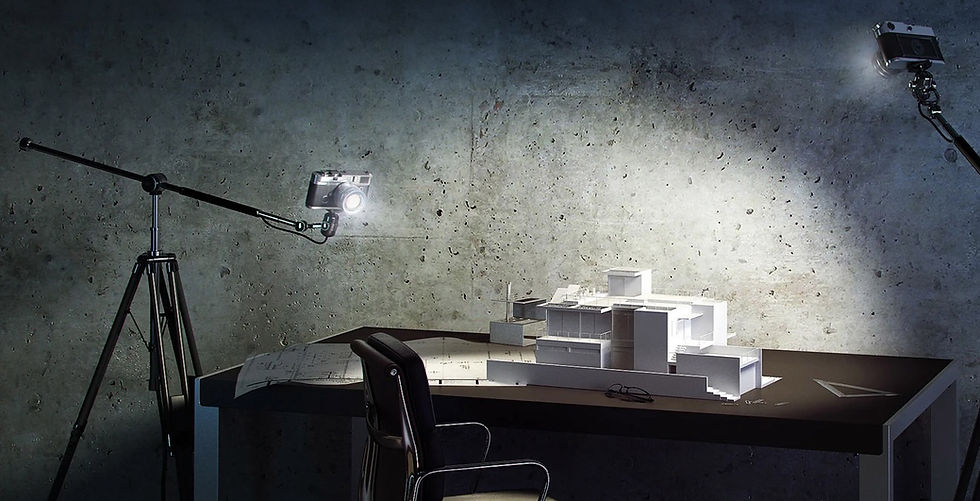How 3d product rendering helps tech companies showcase electronics & gadgets
- Ilya Samokhvalov

- Aug 18
- 8 min read
In the world of tech gadgets and electronics, eye-catching visuals can make or break a product launch. Ever seen a smartphone ad that looks too perfect to be true? Chances are it wasn’t a photograph at all, but a 3D render. Today, 3D product rendering for electronics has become a go-to solution for tech companies to present their devices in the best light. From sleek smartphones to cutting-edge gadgets, photorealistic 3D imagery allows brands to highlight every detail – even the invisible ones – in ways traditional photography simply can’t match.

Table of Contents
Modern consumers have high expectations for product imagery. No one wants to buy a gadget shown in a dim, unflattering photo. That’s why leading tech brands like Apple and Samsung rely on CGI (computer-generated imagery) for many official product images and reveal videos. In this article, we’ll explore how 3D rendering helps tech companies showcase electronics and gadgets, covering the key benefits, real-world examples (from 3D phone renderings to “X-ray” views of devices), and why this trend is taking over tech marketing. By the end, you’ll see why 3D visualization isn’t just for show – it’s a practical tool that can boost marketing, cut costs, and wow customers.

Why tech companies are embracing 3d rendering
Tech companies are turning to 3D rendering because it solves many challenges of showcasing electronics. High-end devices like smartphones, laptops, or smart home gadgets need to look flawless in marketing materials. With 3D rendering, brands can generate photorealistic product images with full control over angles, lighting, and details – resulting in visuals that are often better than real life. Below are some of the key advantages of using CGI for electronics products:

Perfect images from every angle
With 3D rendering, a gadget can be portrayed from its most flattering angles without any physical constraints. Marketers can virtually position a camera anywhere around a digital 3D model to capture the device’s design highlights – something that would be difficult with a physical photo shoot. Want a dramatic low-angle shot of a smartphone or a floating view of a laptop’s profile? CGI makes it possible to get infinite angles and perspectives. This means a tech company can show every side of its product, ensuring the design gets the spotlight it deserves.
Moreover, digital rendering allows perfect control of lighting and reflections. Glossy screens, metallic finishes, and glass panels can all be rendered with ideal lighting – no glare or dust, just a pristine image. The result is a set of marketing images that consistently make the product look its absolute best. It’s no surprise that 3D phone renderings are used heavily in smartphone ads, where each shot needs to be polished and on-brand.

Showing what’s Inside with X-Ray views
A major advantage of 3D visualization for electronics is the ability to show internal components without tearing the product apart. Through techniques like exploded views and “X-ray” style renders, companies can display a device’s inner workings to impress tech-savvy consumers. For example, an X-ray render can make the outer casing semi-transparent, revealing the battery, chipset, camera module, and other components inside a smartphone. This gives buyers a unique look at the engineering quality and features under the hood.
Electronics brands use these internal visuals to build trust and excitement. A phone maker might showcase its advanced processor or cooling system by rendering the chip and heat pipes inside the phone, highlighted in an exploded diagram. High-tech industries widely include exploded and X-ray images in brochures and ads to demonstrate internal engineering quality. It’s a powerful way to communicate “what makes this device different” – for instance, emphasizing a bigger battery or a special camera assembly that competitors don’t have.
Real-world case studies prove how effective this can be. OnePlus, for instance, worked with Transparent House to create a launch video for the OnePlus Nord N20 5G smartphone that literally deconstructed the phone in CGI. The campaign’s visuals showed the phone’s inner workings coming together, highlighting the design and performance features in a futuristic style. The ability to fly through a product and watch its components assemble in 3D is something only CGI can accomplish – and it makes for a memorable product showcase.

Marketing before a product even exists
For fast-paced tech companies, timing is everything. Often, marketing and product launches are planned months before the product is mass-produced – sometimes before a physical prototype is fully ready. This is where 3D rendering becomes a lifesaver. Companies can create lifelike product images and animations before the actual item exists, using CAD files or design data from the engineering team.
Apple famously leverages this advantage. Insiders note that Apple’s iPhones have been 3D modeled for years for use in marketing; physical iPhones aren’t available to photograph until very close to launch, so Apple relies on high-quality renders for packaging and promo images. By doing so, they can start advertising new iPhone models well in advance with impeccable visuals, without waiting on manufacturing.
In short, CGI removes the bottleneck of physical production. A tech brand can unveil a new gadget with splashy 3D renderings – even interactive AR previews – long before the first unit rolls off the assembly line. This accelerates time-to-market for marketing materials and builds hype early, giving companies a competitive edge when timing is critical.

Cost efficiency and consistency
Producing marketing imagery with traditional photography can be expensive and logistically complex – think renting studios, building sets, shipping prototypes, and hiring photographers for each shoot. By contrast, 3D rendering often saves time and money in the long run. Once a detailed 3D model of the product is created, it can generate endless images and even videos with different configurations without additional physical setup. Need the laptop in a different color or the phone at a new angle? No need to reshoot – a 3D artist can adjust materials or camera angles digitally.
This makes scaling up a product launch much more efficient. Brands can ensure a consistent look across all visuals – every image will have matching lighting and style, which is great for branding. For example, a line of gadgets (say, a phone, tablet, and smartwatch) can be rendered in a unified style so that marketing images look cohesive. It’s no wonder some companies choose to render all product shots for consistency.
There’s also evidence that investing in high-quality 3D visuals improves the bottom line. According to Sprout Studios, companies adopting CGI have seen up to 40% higher online conversion rates and a significant reduction in product return rates after using 3D visualization. These results show that photorealistic rendering isn’t just a visual upgrade – it can drive more sales and fewer returns by setting accurate expectations for customers.
And as a digital asset, a 3D model can be reused for future content without starting from scratch – whether it’s creating new images, animations, or interactive demos, the upfront investment keeps paying off.

Real-world examples & trends in CGI for tech
Most flagship electronics today are advertised with 3D-rendered visuals. Apple and Samsung, for instance, rely on CGI in their official product reveal presentations. Those sleek launch videos with phones spinning in perfect light or exploding into component pieces are made possible by 3D rendering. It has become an essential part of how they showcase new devices to the world.
OnePlus provides another great example. When OnePlus launched the Nord N20 5G, they commissioned a fully CGI product video and imagery instead of a traditional photo shoot. Transparent House crafted a futuristic campaign that highlighted the phone’s design and features through high-end 3D animation. The OnePlus team credits this CGI approach with delivering a “best-in-class” visual experience for their product launch – the kind of polish that grabs attention online.
Beyond smartphones, CGI is quickly becoming the norm across the consumer electronics industry. Everything from laptops and VR headsets to speakers and appliances now gets the rendering treatment for ads and product pages. In many cases, the product rendering for electronics is derived straight from the CAD files used in development, ensuring absolute accuracy. Even smaller gadget startups are embracing 3D renders to achieve a high-end look without the cost of elaborate photo shoots. This trend shows no signs of slowing. If anything, it’s expanding: as online shopping moves toward 3D and AR experiences, having ready-to-go 3D models and photorealistic imagery will be even more vital for showcasing products. In short, adopting CGI has gone from an option to a must-have for tech marketing – and companies that master it are staying ahead of the curve.

Frequently Asked Questions (FAQ)
Why are electronics companies using 3D renders instead of photographs?
Using 3D renders allows electronics brands to get perfect product images without the limitations of photography. With CGI, they can control every detail – lighting, angle, background – to make a gadget look flawless. It’s often faster and cheaper than organizing complex photo shoots for devices, especially if the product isn’t fully ready to photograph. Many companies have found that realistic 3D renders can actually boost online sales compared to traditional photos, because the visuals are more consistent and informative.
Can 3D rendering show the inside of a device?
Yes. One big advantage of 3D rendering is that it can create “X-ray” or exploded views. This means the render can make the outer shell transparent or separate parts slightly, revealing internal components like the battery, processor, or wiring. Tech companies use this to showcase the engineering inside a gadget without having to physically cut it open. It’s very useful for marketing – for example, showing a phone’s multiple camera lenses and sensors in an exploded diagram helps explain the technology to customers. These internal views look high-tech and build trust by demonstrating what’s under the hood.
Do 3D product renderings look as realistic as real photos?
When done by professionals, 3D renderings of products can be virtually indistinguishable from real photographs. Modern rendering software simulates lighting and materials so accurately that most people cannot tell the difference. In fact, many smartphone and gadget images you see in ads are 3D renders – and consumers don’t realize it. The keys to realism are detailed 3D modeling and high-quality textures, plus proper lighting in the rendering process. With these in place, the result is a photorealistic image. The benefit is consistency and perfection: no manufacturing defects, no dust or fingerprint smudges, just an idealized but truthful image of the product.
Is 3D rendering cost-effective for gadget marketing?
Absolutely. While there is an upfront cost to create a detailed 3D model of a product, the investment pays off over a marketing campaign. Once the model is ready, you can generate all the imagery you need without additional physical logistics. Need new angles, a different color model, or an update after a minor design tweak? A 3D artist can make those changes digitally, avoiding the expense of another photoshoot. It also saves costs if a product is updated frequently or comes in many variants – you don’t have to photograph each one from scratch. Additionally, using 3D renders early can prevent costly mistakes by catching design issues before manufacturing. Overall, for many tech companies, CGI often ends up cheaper and faster than traditional photography when you consider the entire production process.
How long does it take to create a 3D product rendering?
It depends on the complexity of the product and the number of visuals needed. In many cases, a basic 3D model and still renders for a gadget can be produced within a few days (especially if existing CAD files are provided). Creating a highly detailed model from scratch or making an animated 3D product video might take a week or more. Even so, this process is often faster than organizing a full physical photoshoot, and once the digital model is complete, multiple images or animations can be generated quickly from it.








